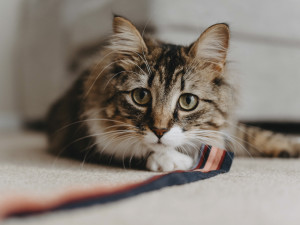Do Cats Like to Be Touched? These Are the Places They Prefer to Be Pet
And the surprising way to get your kitty to be more affectionate.

Share Article
Personally, I don’t like being touched. By most people. In most situations. I don’t even want my own mother to touch me. When she tries, I usually recoil, then she acts like I’m being unreasonable. Other people get defensive or embarrassed, or make a joke at my expense. Almost everyone expects me to explain why I don’t want to be touched by them. I don’t understand why people can’t just let me be and stop making my desire to go unmolested about them.
And yet, when it comes to cats, I’m guilty of the exact same thing: of the kind of physical touch that I deem right and appropriate, even if they clearly are not interested. I feel entitled to it, because I feed them and play with them and clean their litter box. I do this because I love them so much that I think about them when I’m away and long to hold them upon my return.
And besides, few things bring me as much joy as burying my face in their soft bellies and taking a big whiff. And isn’t my enjoyment greater than their discomfort and aren’t my actions therefore justified? I decided to figure out what kind of affection, if any, cats truly want.
Where do cats like to be pet?
First off, you should consider when a cat likes to be pet. Do they like unsolicited touch? In a word: no. But, honestly, until I started researching this article, I kind of thought: yes. Well, I would have said yes if I had thought about this situation at all. But the truth is, I never made the connection before between how I feel about touch and the way some cats feel.

Don't worry, though, it's not that all cats don't like to be touched, more so, they like to be touched on their own terms—a lot like humans. You should start slow and suss out the situation before you approach any cat, especially if it is not your own. “Every cat is going to like different types of contact based on their socialization history, genetics, and personality,” says Joey Lusvardi, certified cat behavior consultant at Class Act Catsopens in new tab.
And you may be surprised to learn the places that cats really do like to be pet—when they show that they are ready for it. While it's often our instinct to run a hand down a cat's back from their neck down to their tail, petting their soft fur, the head and face are actually more preferred spots. Though, again, if you don't know the cat, you may want to keep your hands away from being that close to their teeth until they feel comfortable with you.
“Most cats that enjoy human contact will enjoy being petted on the cheeks, top of the head, or chin,” says Lusvardi. “These areas have a lot of pheromone glands that allow cats to leave their scent on whatever they are rubbing against.”
When it comes to their bodies, Lusvardi says some cats like having the base of their tail scratched. “Though this can also be an area that leads to overstimulation, so be cautious with that area,” he warns. “Other cats may prefer laying on your lap, but not being petted. They may like the warmth or they may feel safe being near you, but not like the way being petted feels.”
Do cats like to be cuddled?
When it comes to being cuddled or hugged, very few cats enjoy that. “Hugs are more enjoyable for us than they are for cats,” Lusvardi says. And even if your cat isn’t fighting to get away from your hug, that doesn’t mean they like it. “People misinterpret their cat being frozen with fear and not fighting a hug with enjoying it. Cats feel like they are being restrained or can’t escape a situation during a hug, rather than it being a fun or enjoyable experience. Some cats may enjoy being held, but not every cat likes that kind of physical contact from us.”
However, that same cat can still enjoy the physical affection of another cat, as was the case with my cat Bear, who loved snuggling with my other cat Pumpkin, but was less enthused by my touch (at least in the beginning). “Your cat might like snuggling with another cat more because the other cat has better respect for their boundaries and backs off if they give signals of discomfort or not wanting to be touched,” says Lusvardi. “It may also be that, because they're closer in size and shape to each other, they prefer the way spooning with the other cat feels. There are a lot of possibilities!”
As challenging as it may be, we need to resist the urge to force ourselves on our cats, if we want to avoid alienating them even more. “Eventually your cats will learn that you are associated with discomfort and may choose to limit the times of interactions they have with you,” says Lusvardi.
Can a cat become more affectionate?
It is possible to train your cat to be more physically affectionate, but only to a degree. Many cats will just become more open to touch, especially from their pet parent, as they spend more time with you.
“If you go slowly and are patient, you can help your cat learn that physical interactions aren't so bad,” says Lusvardi. “As strange as it sounds, one of the best ways to get a cat to like being touched more is to stop trying to touch them as much. Let them be in control of all interactions and only touch them if they initiate contact first. Even then, limit the amount of physical interaction you do and let them reinitiate contact if they are enjoying it. Over time, they'll learn that they can trust you to back off if they're not enjoying something and be okay with pets on their terms.”
And then there are those cats who will never enjoy physical affection, but that doesn’t mean they don’t deserve to live in a safe and loving home. Cats do not owe us their physical selves in exchange for room and board. The same way we do not owe anyone else access to our bodies, no matter what they might do that makes them feel entitled to them.
This can be a really hard pill for cat lovers to swallow, but it gets easier if you look at taking care of a cat as an act of service and focus on what you can do for them, rather than what they can do for you. At the end of the day, your cat is a living, thinking, feeling creature. That’s why you love them so much. And if you want to do right by them, you need to respect their autonomy and touch them or not touch them according to their wishes, even if you want nothing more than to bury your face in their soft fluffy bellies and just take a big whiff.
As I’m writing this, I’m looking at a cat I’ve been cat-sitting for the past month. She hates being touched and yet, I’ve often tried to give her a scratch or a stroke even when she rejects my advances. I’m doing to her what everyone else does to me, and I regret it.
Are there worse things I could do than trying to show her physical affection? Absolutely. But that doesn’t mean doing so is OK. Cats deserve the same physical autonomy we do and since they can’t verbalize their wants explicitly, it is up to us to read the cues we can and respect their wishes.

Charles Manning
Charles Manning is an actor and writer based in New York City. In his free time he likes to cook, go swimming at the public pool, volunteer at the LGBTQ senior center, and foster senior and special-needs cats. His work has previously appeared in Cosmopolitan, Elle, Marie Claire, Harper’s Bazaar, Seventeen, and Nylon.
Related articles
Can Cats Have ADHD?
A question you may be asking after you observe any number of their behaviors...
![A cute cat laying on the ground with wide eyes]()
Why Do Cats Slow Blink?
Here’s what your cat’s favorite move means.
Can Cats Smile? 5 Signs of Really Happy Cats
My, what lovely teeth they have...
Why Does My Cat Sleep at My Feet?
Other than the fact that they love you so very much.
![illustration of a dog in a pool with a pink hat and pink shoes]()
Anthropomorphizing Your Pets Can Actually Benefit Them—and You
If your friends make fun of you for treating your dog like a human being, send them this.
![Cat kneading pet parent]()
Why Does My Cat Knead Me?
Among other things, “making biscuits” is a sign of affection. We’re not crying…








